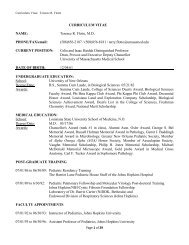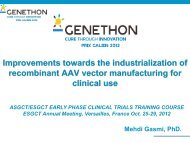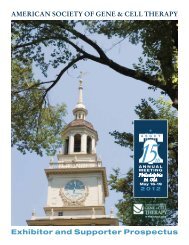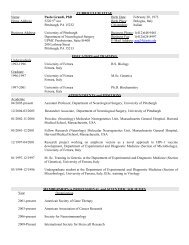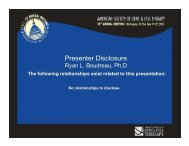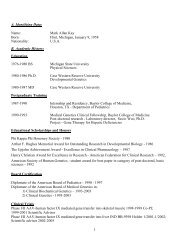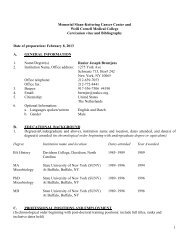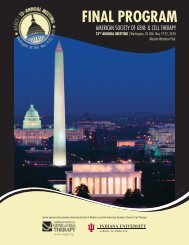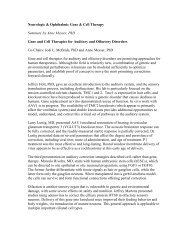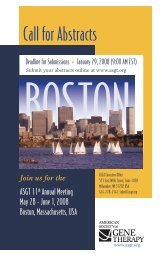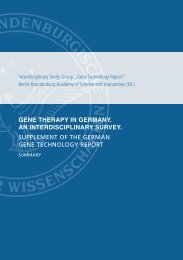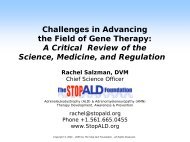Final Program - American Society of Gene & Cell Therapy
Final Program - American Society of Gene & Cell Therapy
Final Program - American Society of Gene & Cell Therapy
Create successful ePaper yourself
Turn your PDF publications into a flip-book with our unique Google optimized e-Paper software.
<strong>Program</strong> Schedule, Saturday, May 18, 2013<br />
Scientific Symposium 434<br />
1:45 pm - 3:45 pm<br />
ROOM: 151 ABCG<br />
Lessons Learned from the Manufacture and Clinical Translation <strong>of</strong> <strong>Gene</strong> and <strong>Cell</strong> <strong>Therapy</strong><br />
Products<br />
CO-CHAIRS: <strong>Gene</strong> Liau, PhD and Gabor Veres, PhD<br />
SPEAKERS<br />
Barrie J. Carter, PhD<br />
Overview on Product and Clinical Translation<br />
After two decades <strong>of</strong> development, the irst gene therapy in the western world that was recently approved for marketing in Europe<br />
was an rAAV, glybera. The progress over these two decades in developing and testing gene therapy products will be reviewed using<br />
rAAV as the illustrative example. Substantial progress has been made in scaled up production <strong>of</strong> rAAV vectors, at least ive different<br />
manufacturing systems have been employed to advance products into clinical testing. The puriication and quality testing <strong>of</strong> rAAV<br />
vectors has advanced signiicantly and as more products approach licensing analytics for rAAV will be further reined. Pathways<br />
for preclincal testing <strong>of</strong> rAAV for safety, toxicity and biodistribution are established. Importantly, clinical studies with rAAV have<br />
generated clear evidence that clinical beneits can be gained and have also illuminated some important considerations such as host<br />
immune responses.<br />
Harold Petry, PhD<br />
Lessons from the Glybera ® European Approval Process to Build a <strong>Gene</strong> <strong>Therapy</strong> Product Pipeline<br />
The presentation will cover the development <strong>of</strong> Glybera ® , a gene therapy product based on the use <strong>of</strong> recombinant Adenoassociated<br />
virus for gene delivery, designed for patients with Lipoprotein Lipase Deiciency. The European Medicines Agency’s<br />
Committee for Medicinal Products for Human Use (CHMP) has approved authorisation <strong>of</strong> Glybera (alipogene tiparvovec) for<br />
marketing in the European Union. It is intended to treat lipoprotein lipase (LPL) deiciency in patients with severe or multiple<br />
pancreatitis attacks, despite dietary fat restrictions. Hurdles which were recognized during the development program towards<br />
market authorization will be discussed.<br />
Bruce L. Levine, PhD<br />
<strong>Gene</strong>ration <strong>of</strong> T <strong>Cell</strong>s that Engraft, Expand and Persist<br />
Dr. Levine directs the Clinical <strong>Cell</strong> and Vaccine Production Facility and is an Associate Pr<strong>of</strong>essor in the Department <strong>of</strong> Pathology<br />
and Laboratory Medicine at the University <strong>of</strong> Pennsylvania. The CVPF develops, manufactures and tests novel cell and gene<br />
therapies in clinical trials at Penn and collaborating institutions. Critical components for generation <strong>of</strong> cells with non-homologous<br />
function include 1) source and isolation <strong>of</strong> cells, 2) method <strong>of</strong> activation, 3) method <strong>of</strong> expansion, 4) characterization and testing. T<br />
lymphocytes can be activated, cultured, and endowed with novel functions ex vivo. Ex vivo modiied cells can engraft, signiicantly<br />
expand in vivo by >1000 fold, mediate potent clinical responses, and can survive for years.<br />
Raymond T. Bartus, PhD<br />
CERE-120 (AAV-neurturin) for the Treatment <strong>of</strong> Parkinson’s Disease: Experience from 4 Clinical Trials and<br />
Human Autopsy Data<br />
CERE-120 is an AAV serotype 2 vector expressing the gene for human neurturin, a neurotrophic factor with the natural ability<br />
to protect dying dopaminergic neurons in Parkinson’s patients from cell death and stimulate their ability to produce tyrosine<br />
hydroxylase (TH), an enzyme necessary dopamine synthesis. Since CERE-120 can inhibit cell death and stimulate dopamine, it has<br />
the potential ability to provide both symptomatic improvement as well as slow the neurodegenerative process, hence be disease<br />
modifying. Ceregene has completed over 24 preclinical studies on CERE-120 in multiple animal models <strong>of</strong> Parkinson’s disease as<br />
well as multiple preclinical toxicology studies. Ceregene has completed 4 CERE-120 clinical trials including 2 Phase 1 studies and 2<br />
Phase 2/2b studies in Patients with moderately advanced Parkinson’s disease. Data from these studies as well as from the analysis<br />
<strong>of</strong> 4 brains obtained at autopsy from subjects treat with CERE-120 will be discussed.<br />
Saturday, May 18, 2013<br />
<strong>Final</strong> <strong>Program</strong> SALT LAKE CITY, UTAH May 15–18, 2013<br />
75



